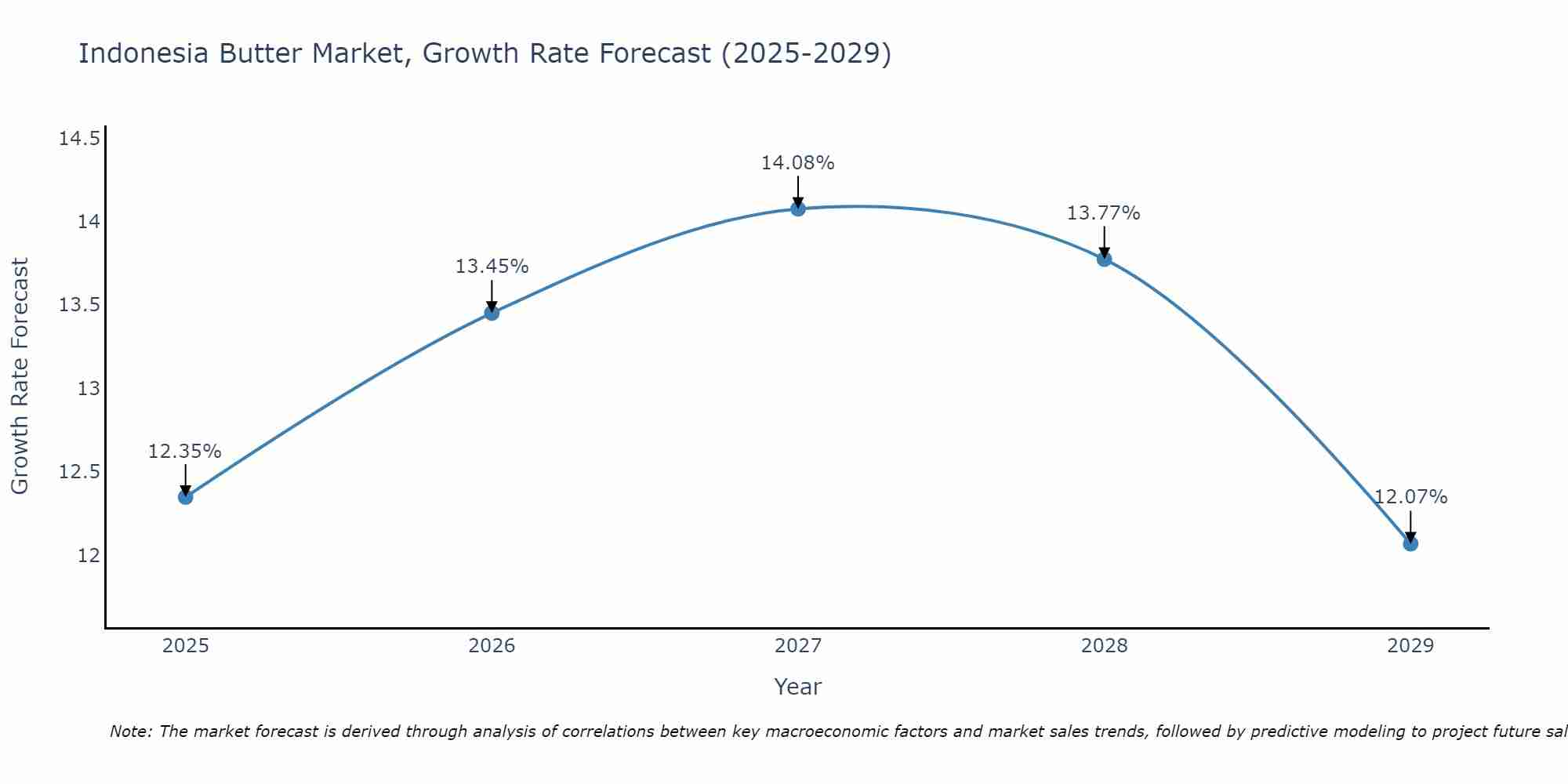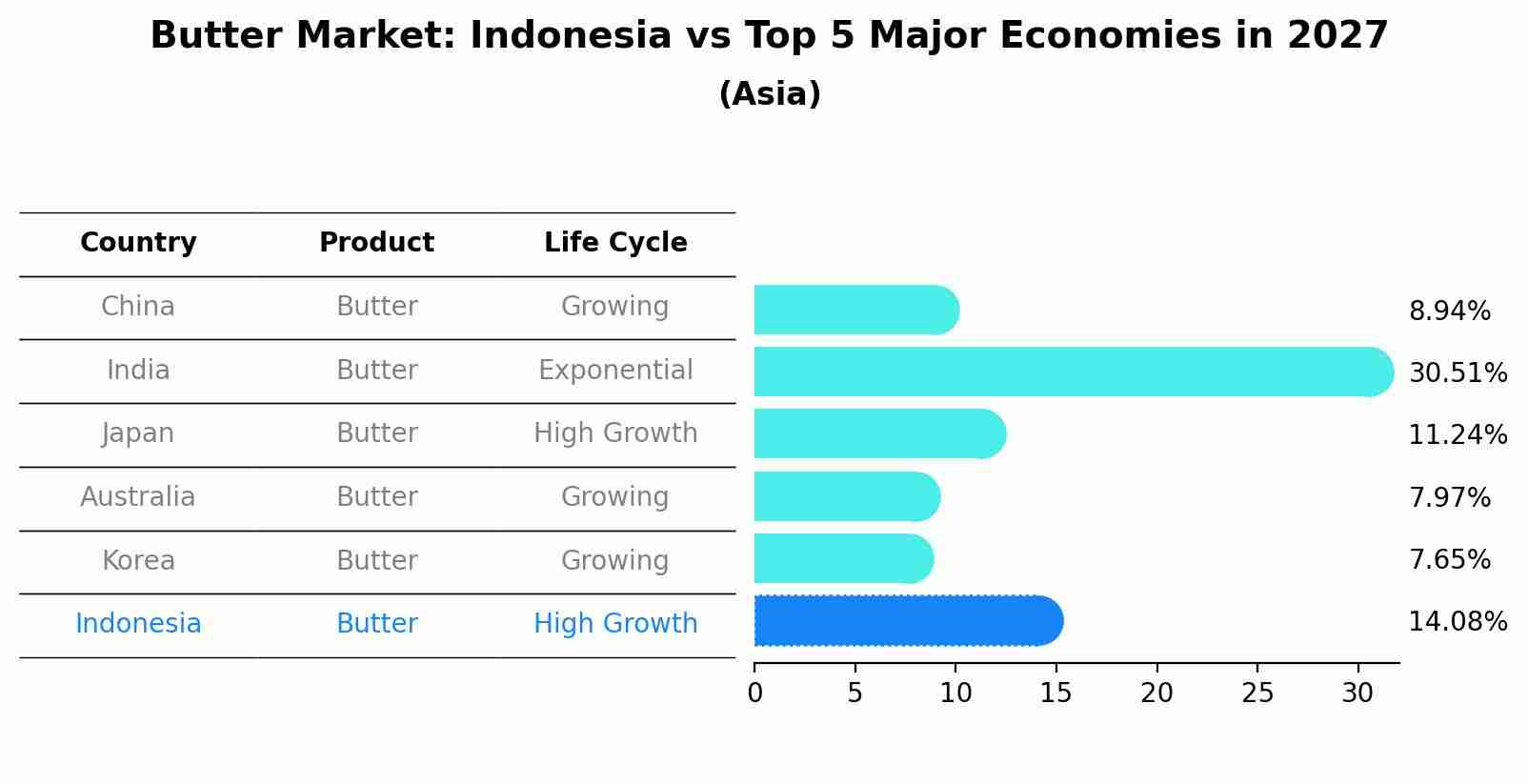Indonesia Butter Market | Companies, Size, Revenue, Share, Analysis, Industry, Trends, Forecast, Growth, COVID-19 IMPACT & Value
| Product Code: ETC180527 | Publication Date: Jul 2023 | Updated Date: Aug 2025 | Product Type: Market Research Report | |
| Publisher: 6Wresearch | No. of Pages: 70 | No. of Figures: 35 | No. of Tables: 5 | |
Indonesia Butter Market Size Growth Rate
The Indonesia Butter Market is projected to witness mixed growth rate patterns during 2025 to 2029. Growth accelerates to 14.08% in 2027, following an initial rate of 12.35%, before easing to 12.07% at the end of the period.

Butter Market: Indonesia vs Top 5 Major Economies in 2027 (Asia)
Indonesia's Butter market is anticipated to experience a high growth rate of 14.08% by 2027, reflecting trends observed in the largest economy China, followed by India, Japan, Australia and South Korea.

Indonesia Butter Market Synopsis
Indonesia is one of the leading producers and consumers of butter in Asia. The country has a long history of dairy production, with a growing focus on quality products from modern manufacturing techniques that take advantage of traditional recipes. Butter consumption in Indonesia is increasing due to rising incomes and improved access to high-quality food ingredients.
Market Trends
The demand for butter in Indonesia continues to increase due to its versatility as an ingredient for baking, cooking, sauces, desserts, etc., along with more people becoming health conscious and opting for healthier fats like butter instead of other unhealthy alternatives such as margarine or shortening. Additionally, there has been an increased preference for imported premium brands over local brands which offer greater quality control than some local competitors. Furthermore, the rise in home delivery services have also helped boost sales as people are able to order items conveniently from their homes without having to leave them making it easier and safer during the pandemic period when social distancing norms are being followed rigidly by most countries across the world.
Market Drivers
The growing awareness about healthy eating habits among Indonesias is driving up demand for better-quality products like butter which contain unsaturated fats rather than saturated ones compared with margarines or shortening used previously. Increasing disposable incomes also mean that customers now have higher purchasing power so they can afford premium imported products that may be priced slightly higher but offer superior taste and texture compared with local options. Finally evolving online retail platforms have further promoted purchase convenience through internet shopping sites thus making them popular even amongst those who don?t frequent physical stores often or prefer staying at home during this pandemic situation.
COVID-19 Impact on the Market
The COVID-19 pandemic has had a major impact on Indonesia butter market, as sales and production levels have significantly decreased. This is due to the country`s public health measures that were put in place to limit the spread of the virus. Additionally, disruptions in supply chains and logistics have also led to reduced availability of butter imports from other countries.
Challenges of the Market
Due to the current economic downturn caused by COVID-19, consumers are more likely to opt for cheaper alternatives such as margarine or vegetable oils. Furthermore, rising prices of dairy products due to lower supplies has also had an impact on consumer demand for butter in domestic markets. The outbreak has also hindered marketing efforts and consumer awareness campaigns which makes it difficult for companies operating in this sector to increase their market share through traditional promotional activities.
Industry Key Players
The key players in Indonesia butter market include PT Nestle Indonesia, PT Indofood Sukses Makmur Tbk., Unilever Indonesia Corporation, Wings Food Tbk., Danone Aqua Group, Bimoli Oils & Fats Co., Sariwangi Tea Industry Co Ltd., Britannia Industries Ltd., Japfa Comfeed Co Ltd and Ikan Segar Abadi Services Corp Ltd.
Key Highlights of the Report:
- Indonesia Butter Market Outlook
- Market Size of Indonesia Butter Market, 2023
- Forecast of Indonesia Butter Market, 2030
- Historical Data and Forecast of Indonesia Butter Revenues & Volume for the Period 2020-2030
- Indonesia Butter Market Trend Evolution
- Indonesia Butter Market Drivers and Challenges
- Indonesia Butter Price Trends
- Indonesia Butter Porter's Five Forces
- Indonesia Butter Industry Life Cycle
- Historical Data and Forecast of Indonesia Butter Market Revenues & Volume By Product Type for the Period 2020-2030
- Historical Data and Forecast of Indonesia Butter Market Revenues & Volume By Cultured Butter for the Period 2020-2030
- Historical Data and Forecast of Indonesia Butter Market Revenues & Volume By Uncultured Butter for the Period 2020-2030
- Historical Data and Forecast of Indonesia Butter Market Revenues & Volume By Others for the Period 2020-2030
- Historical Data and Forecast of Indonesia Butter Market Revenues & Volume By Distribution Channel for the Period 2020-2030
- Historical Data and Forecast of Indonesia Butter Market Revenues & Volume By Supermarkets/Hypermarkets for the Period 2020-2030
- Historical Data and Forecast of Indonesia Butter Market Revenues & Volume By Convenience Stores for the Period 2020-2030
- Historical Data and Forecast of Indonesia Butter Market Revenues & Volume By Specialty Stores for the Period 2020-2030
- Historical Data and Forecast of Indonesia Butter Market Revenues & Volume By Online Retail Stores for the Period 2020-2030
- Historical Data and Forecast of Indonesia Butter Market Revenues & Volume By Other Distribution Channels for the Period 2020-2030
- Indonesia Butter Import Export Trade Statistics
- Market Opportunity Assessment By Product Type
- Market Opportunity Assessment By Distribution Channel
- Indonesia Butter Top Companies Market Share
- Indonesia Butter Competitive Benchmarking By Technical and Operational Parameters
- Indonesia Butter Company Profiles
- Indonesia Butter Key Strategic Recommendations
Frequently Asked Questions About the Market Study (FAQs):
1 Executive Summary |
2 Introduction |
2.1 Key Highlights of the Report |
2.2 Report Description |
2.3 Market Scope & Segmentation |
2.4 Research Methodology |
2.5 Assumptions |
3 Indonesia Butter Market Overview |
3.1 Indonesia Country Macro Economic Indicators |
3.2 Indonesia Butter Market Revenues & Volume, 2020 & 2030F |
3.3 Indonesia Butter Market - Industry Life Cycle |
3.4 Indonesia Butter Market - Porter's Five Forces |
3.5 Indonesia Butter Market Revenues & Volume Share, By Product Type, 2020 & 2030F |
3.6 Indonesia Butter Market Revenues & Volume Share, By Distribution Channel, 2020 & 2030F |
4 Indonesia Butter Market Dynamics |
4.1 Impact Analysis |
4.2 Market Drivers |
4.2.1 Increasing consumer awareness about the health benefits of butter |
4.2.2 Growing demand for premium and specialty butter products |
4.2.3 Rise in disposable income leading to higher purchasing power for butter |
4.3 Market Restraints |
4.3.1 Fluctuating prices of raw materials such as milk |
4.3.2 Competition from alternative spreads like margarine and plant-based butter substitutes |
4.3.3 Regulatory challenges related to food safety standards and labeling requirements |
5 Indonesia Butter Market Trends |
6 Indonesia Butter Market, By Types |
6.1 Indonesia Butter Market, By Product Type |
6.1.1 Overview and Analysis |
6.1.2 Indonesia Butter Market Revenues & Volume, By Product Type, 2020-2030F |
6.1.3 Indonesia Butter Market Revenues & Volume, By Cultured Butter, 2020-2030F |
6.1.4 Indonesia Butter Market Revenues & Volume, By Uncultured Butter, 2020-2030F |
6.1.5 Indonesia Butter Market Revenues & Volume, By Others, 2020-2030F |
6.2 Indonesia Butter Market, By Distribution Channel |
6.2.1 Overview and Analysis |
6.2.2 Indonesia Butter Market Revenues & Volume, By Supermarkets/Hypermarkets, 2020-2030F |
6.2.3 Indonesia Butter Market Revenues & Volume, By Convenience Stores, 2020-2030F |
6.2.4 Indonesia Butter Market Revenues & Volume, By Specialty Stores, 2020-2030F |
6.2.5 Indonesia Butter Market Revenues & Volume, By Online Retail Stores, 2020-2030F |
6.2.6 Indonesia Butter Market Revenues & Volume, By Other Distribution Channels, 2020-2030F |
7 Indonesia Butter Market Import-Export Trade Statistics |
7.1 Indonesia Butter Market Export to Major Countries |
7.2 Indonesia Butter Market Imports from Major Countries |
8 Indonesia Butter Market Key Performance Indicators |
8.1 Consumer engagement on social media platforms for butter-related content |
8.2 Number of new product launches and innovations in the butter market |
8.3 Growth in per capita butter consumption in Indonesia |
9 Indonesia Butter Market - Opportunity Assessment |
9.1 Indonesia Butter Market Opportunity Assessment, By Product Type, 2020 & 2030F |
9.2 Indonesia Butter Market Opportunity Assessment, By Distribution Channel, 2020 & 2030F |
10 Indonesia Butter Market - Competitive Landscape |
10.1 Indonesia Butter Market Revenue Share, By Companies, 2023 |
10.2 Indonesia Butter Market Competitive Benchmarking, By Operating and Technical Parameters |
11 Company Profiles |
12 Recommendations |
13 Disclaimer |
- Single User License$ 1,995
- Department License$ 2,400
- Site License$ 3,120
- Global License$ 3,795
Search
Related Reports
- Portugal Electronic Document Management Market (2025-2031) | Strategy, Consumer Insights, Analysis, Investment Trends, Opportunities, Growth, Size, Share, Industry, Revenue, Segments, Value, Segmentation, Supply, Forecast, Restraints, Outlook, Competition, Drivers, Trends, Demand, Pricing Analysis, Competitive, Strategic Insights, Companies, Challenges
- France Electronic Document Management Market (2025-2031) | Strategy, Consumer Insights, Analysis, Investment Trends, Opportunities, Growth, Size, Share, Industry, Revenue, Segments, Value, Segmentation, Supply, Forecast, Restraints, Outlook, Competition, Drivers, Trends, Demand, Pricing Analysis, Competitive, Strategic Insights, Companies, Challenges
- Portugal Occupational Health & Safety Services Market (2025-2031) | Strategy, Consumer Insights, Analysis, Investment Trends, Opportunities, Growth, Size, Share, Industry, Revenue, Segments, Value, Segmentation, Supply, Forecast, Restraints, Outlook, Competition, Drivers, Trends, Demand, Pricing Analysis, Competitive, Strategic Insights, Companies, Challenges
- Netherlands Occupational Health and Safety Services Market (2025-2031) | Strategy, Consumer Insights, Analysis, Investment Trends, Opportunities, Growth, Size, Share, Industry, Revenue, Segments, Value, Segmentation, Supply, Forecast, Restraints, Outlook, Competition, Drivers, Trends, Demand, Pricing Analysis, Competitive, Strategic Insights, Companies, Challenges
- Belgium and Luxembourg Facility Management Market (2025-2031) | Strategy, Consumer Insights, Analysis, Investment Trends, Opportunities, Growth, Size, Share, Industry, Revenue, Segments, Value, Segmentation, Supply, Forecast, Restraints, Outlook, Competition, Drivers, Trends, Demand, Pricing Analysis, Competitive, Strategic Insights, Companies, Challenges
- Russia Women Intimate Apparel Market (2025-2031) | Strategy, Consumer Insights, Analysis, Investment Trends, Opportunities, Growth, Size, Share, Industry, Revenue, Segments, Value, Segmentation, Supply, Forecast, Restraints, Outlook, Competition, Drivers, Trends, Demand, Pricing Analysis, Competitive, Strategic Insights, Companies, Challenges
- Africa Chocolate Market (2025-2031) | Size, Share, Trends, Growth, Revenue, Analysis, Forecast, industry & Outlook
- Global Hydroxychloroquine And Chloroquine Market (2025-2031) | Industry, Trends, Size, Outlook, Growth, Value, Companies, Revenue, Analysis, Share, Forecast
- Saudi Arabia Plant Maintenance Market (2025-2031) | Industry, Size, Growth, Revenue, Value, Companies, Forecast, Analysis, Share & Trends
- Taiwan Electric Truck Market (2025-2031) | Outlook, Industry, Revenue, Size, Forecast, Growth, Analysis, Share, Companies, Value & Trends
Industry Events and Analyst Meet
Our Clients
Whitepaper
- Middle East & Africa Commercial Security Market Click here to view more.
- Middle East & Africa Fire Safety Systems & Equipment Market Click here to view more.
- GCC Drone Market Click here to view more.
- Middle East Lighting Fixture Market Click here to view more.
- GCC Physical & Perimeter Security Market Click here to view more.
6WResearch In News
- Doha a strategic location for EV manufacturing hub: IPA Qatar
- Demand for luxury TVs surging in the GCC, says Samsung
- Empowering Growth: The Thriving Journey of Bangladesh’s Cable Industry
- Demand for luxury TVs surging in the GCC, says Samsung
- Video call with a traditional healer? Once unthinkable, it’s now common in South Africa
- Intelligent Buildings To Smooth GCC’s Path To Net Zero













